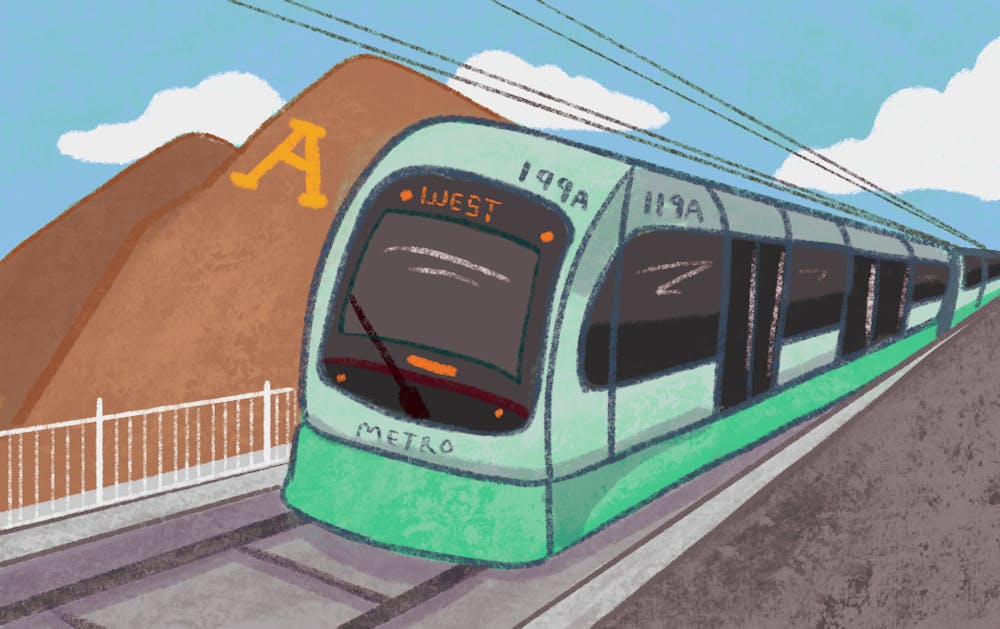Maricopa County's efforts in electrifying its public transportation could have great benefits for the county, but to assess its true effects, an ASU research team is creating a model that could help predict pollution trends across the nation.
On Aug. 14, the Environmental Protection Agency (EPA) announced that a research team at ASU was given an almost $650,000 grant to research energy proposals in underserved communities.
This project, "Environmental Justice Implications of Public Transit Electrification and Changing Generation Portfolios in Arizona," will look at the spread of emissions through Maricopa County and how it may respond to the county’s plans for public transport electrification.
This project centers on environmental justice to bring attention and solutions to the areas most affected by pollution because, as the team's researchers point out, pollution is not equally distributed.
Danae Hernandez-Cortes is the project’s principal investigator. She is a senior global futures scientist with the Global Futures Scientists and Scholars and an assistant professor in the School of Sustainability and the School for the Future of Innovation in Society.
"This is a very strong finding across the whole literature in environmental science and economics ... that low-income and minority communities are the ones that experience the highest concentration of pollution," Hernandez-Cortes said. "The origin of that is for many reasons, some of it is some policies that have affected these communities like redlining and other barriers of access to housing."
This research will be funded through the end of September 2026. In that time, the team will be developing models to predict pollution in Maricopa County as a response to the electrification of public transit like buses and shuttles. The goal is to eventually apply these models to communities across the country, with the hope of predicting their pollution trends as well.
"The whole idea of this type of grant is to contribute to the discussion here in Maricopa, but to also see what insights from Maricopa can be applied to the whole U.S.," Hernandez-Cortes said.
This research will use a few different models to understand the full impact of Maricopa County’s transport electrification.
"We’re going to use this pollution transport model to model how different electrification scenarios of transport vehicles could benefit air pollution for disadvantaged communities using atmospheric transport models," Hernandez-Cortes said.
Atmospheric transport models show the path of pollution due to atmospheric factors like climate and wind patterns. This will be compared to census data to look at the demographics of neighborhoods most affected by the emissions.
Deepti Paul, a Ph.D. student in the sustainable energy program, works on creating models for this research.
"I model the electricity dispatch model, it is basically all the power plants in Arizona, and then the way (energy) is dispatched according to the demand," Paul said.
Paul previously worked on similar research with Hernandez-Cortes, and the models she developed will heavily contribute to this current project. However, like with all models, the process requires constant collection and correction.
"We try to aggregate and include renewables and everything in (the models), so we can study the scenarios for emissions and air pollution," Paul said. "Once we think there's more data that can go into it, we try to get those data and put it in the model ... it's an iterative work so we can get a good result at the end."
Ultimately, the goal of this research is to guide policy decisions for public transport electrification, to find where inequalities in pollution distribution exist, and what policies could reduce the gap.
Glenn Sheriff is an associate professor at the School of Politics and Global Studies and a Senior Global Futures Scholar. He is also another member of the research team and explained why community-based modeling is critical to emissions studies.
"As Phoenix, for example, moves to its electrification of buses, it's going to reduce pollution near the bus routes. But if that electricity is generated by fossil fuels, it's going to increase pollution downwind of those generation stations … You can't answer those types of questions without the models Danae is working on," Sheriff said.
Sheriff and Hernandez-Cortes are also working closely with the (project's) community partner, Unlimited Potential, to guide this research and make it relevant to the communities that could benefit from it.
"The first couple years are incorporating some of the listening sessions our community partners are going to be doing in order to inform our research and get context of all the existing policies in the valley. Next, we will start modeling these scenarios," Hernandez-Cortes said.
The official start for this project is Oct. 1, but ASU students can still engage with this project before it begins.
"If there are students or anyone who wants to get in touch, we will be very happy to talk about this. If there are students or other researchers who are working on environmental justice, let us know because we would like to create more networks within ASU," said Hernandez-Cortes.
Edited by River Graziano, Walker Smith and Grace Copperthite.
Reach the reporter at syramir2@asu.edu and follow @nerdyoso on X.
Like The State Press on Facebook and follow @statepress on X.
Sophia is a senior studying biological sciences. This is her fifth semester with The State Press. She has also worked as a science and technology reporter.




